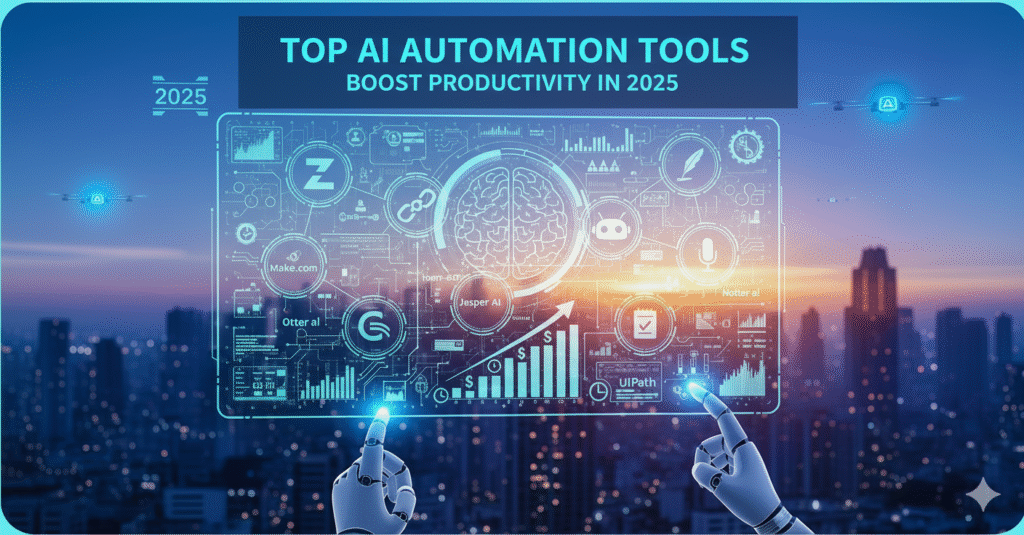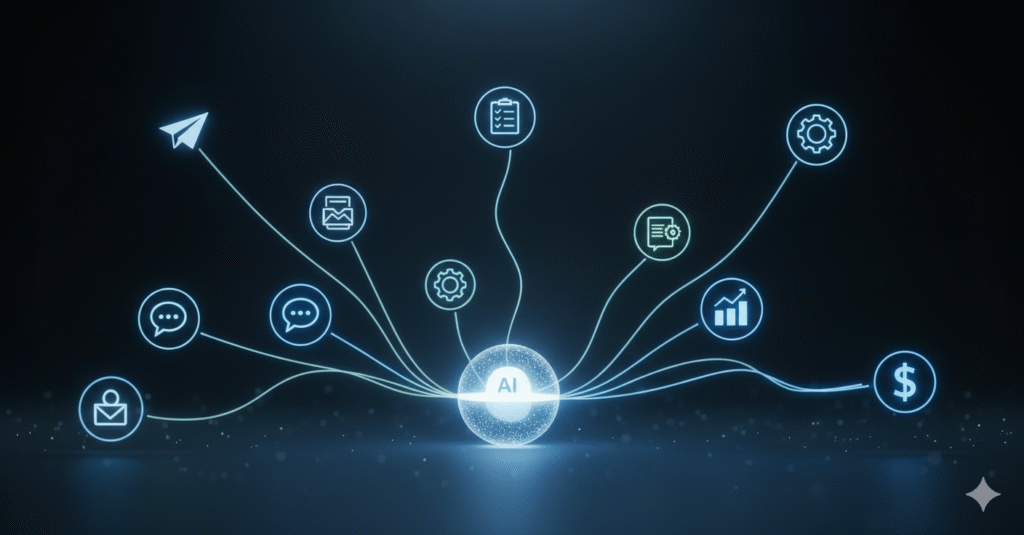In today’s fast-paced digital era, productivity has become more important than ever. Businesses, entrepreneurs, and individuals are constantly looking for ways to save time and achieve more with less effort. This is where AI automation tools come into play. These advanced tools leverage artificial intelligence to automate repetitive and time-consuming tasks, helping users focus on more strategic and creative work.

As we step into 2025, the demand for smarter solutions is growing rapidly. Productivity is no longer just about working harder; it’s about working smarter. By integrating AI automation tools into daily workflows, tasks like email management, data entry, social media scheduling, and workflow coordination can be handled efficiently and accurately. These tools not only reduce manual effort but also help boost productivity by freeing up time for high-value activities.
Moreover, AI automation ensures consistency and minimizes human errors, making processes more reliable. Whether you are managing a small business, a large team, or personal projects, adopting AI automation tools can transform the way you work. Embracing these technologies in 2025 is key to staying competitive, organized, and efficient in an increasingly digital world.
What Are AI Automation Tools?
AI automation tools are software applications that use artificial intelligence to perform repetitive tasks automatically. Unlike traditional automation tools, which require manual configuration for every action, AI automation tools can learn from data, recognize patterns, and execute tasks intelligently. They help businesses and individuals save time, reduce errors, and improve overall efficiency.

Key Features of AI Automation Tools
AI automation tools come with a variety of powerful features that make workflow management seamless:
Email Automation: Sends personalized emails and notifications based on triggers.
Workflow Automation: Automates complex, multi-step processes across different apps.
Task Scheduling: Sets up recurring tasks and reminders without manual input.
Data Analysis: Collects, organizes, and interprets data to generate actionable insights.
Benefits for Businesses and Individuals
Using AI automation tools provides significant advantages:
Time-Saving: Frees up hours spent on repetitive tasks.
Error Reduction: Minimizes mistakes in routine processes.
Efficiency Boost: Enables users to focus on strategic and creative work.
Scalability: Handles growing workloads without additional resources.
In essence, AI automation tools are not just about replacing human effort—they enhance productivity by streamlining operations and making workflows smarter. Adopting these tools in 2025 allows businesses and individuals to work more efficiently, consistently, and intelligently. By leveraging AI, users can truly boost productivity while minimizing time spent on routine tasks.
Top AI Automation Tools in 2025
With the rise of digital workflows, AI automation tools have become essential for boosting productivity. These tools help streamline repetitive tasks, improve efficiency, and allow teams and individuals to focus on high-value activities. Here are some of the top AI automation tools in 2025 that can transform your workflow.

Zapier
Zapier is one of the most popular AI automation tools, connecting over 5,000 apps seamlessly. It allows users to create automated workflows, known as “Zaps,” that trigger actions across multiple platforms.
Features: Multi-step workflows, app integrations, custom triggers.
Use Cases: Automatically send emails when a new lead is added, update spreadsheets, post on social media.
Benefits: Saves time, reduces human errors, and improves team coordination.
Make (formerly Integromat)
Make offers a visual automation builder, making it easy to design complex workflows without coding. It supports a wide range of integrations and advanced automation scenarios.
Features: Visual scenario builder, real-time monitoring, extensive app library.
Use Cases: Sync data between apps, automate project management tasks, generate reports.
Benefits: Flexibility, efficiency, and scalability for both small and large businesses.
IFTTT (If This Then That)
IFTTT is a simple yet powerful tool that allows users to automate actions based on triggers. It is ideal for personal productivity as well as small business automation.
Features: Trigger-based workflows, applets for easy automation.
Use Cases: Post content automatically on multiple social media platforms, smart home automation, email alerts.
Benefits: Easy to use, beginner-friendly, and cost-effective.
Trello + Butler AI
Trello’s Butler AI enhances project management by automating repetitive tasks within boards. It’s perfect for teams managing multiple projects.
Features: Card and board automation, rule-based triggers, scheduled commands.
Use Cases: Automatically assign tasks, move completed tasks, send reminders.
Benefits: Saves time on project management, ensures tasks are tracked efficiently.
Notion AI
Notion AI combines task management, note-taking, and workflow automation. It is particularly useful for teams needing organized collaboration.
Features: AI-generated content, task automation, reminders, collaborative notes.
Use Cases: Generate meeting notes, automate task updates, streamline team communication.
Benefits: Enhances productivity, improves collaboration, reduces manual effort.
Other Notable AI Automation Tools
Microsoft Power Automate: Enterprise-level automation with advanced integration and AI capabilities.
HubSpot AI: Automates CRM tasks, email sequences, and marketing workflows.
UiPath: Robotic Process Automation (RPA) for large-scale business processes.
These tools demonstrate how AI automation can boost productivity in 2025, whether you are a small business owner, freelancer, or part of a large organization. By integrating the right tool into your workflow, you can save time, reduce errors, and focus on strategic growth.
How AI Automation Tools Boost Productivity
AI automation tools are designed to simplify tasks and save time, allowing individuals and businesses to focus on high-value work. By automating repetitive and time-consuming activities, these tools significantly enhance productivity and operational efficiency.

Automating Repetitive Tasks
One of the primary ways AI automation tools boost productivity is by handling repetitive tasks. Tasks such as data entry, email responses, social media posting, and report generation can be automated, reducing manual effort. This not only saves time but also minimizes human errors, ensuring that processes are consistent and reliable. By freeing up hours spent on routine work, users can dedicate more time to strategic planning and creative projects.
Improving Team Collaboration
AI automation tools also enhance team collaboration. Features like automated task assignments, real-time updates, and workflow notifications ensure that everyone stays on the same page. Teams can track progress, manage deadlines, and coordinate tasks more effectively. Tools like Trello + Butler AI and Notion AI make collaboration seamless, allowing team members to focus on problem-solving rather than administrative work.
Streamlining Workflow and Decision Making
AI tools can analyze large amounts of data and provide actionable insights, helping teams make faster and better decisions. Automation streamlines workflow by connecting multiple apps and systems, reducing bottlenecks, and ensuring smoother operations. This leads to higher efficiency and overall productivity gains.
In 2025, leveraging AI automation tools is not just a convenience—it is a necessity for businesses and individuals looking to boost productivity. By reducing manual work, improving collaboration, and streamlining decision-making, these tools empower users to achieve more in less time while maintaining high-quality outcomes.
Choosing the Right AI Automation Tool
Selecting the right AI automation tool is crucial to ensure maximum productivity and efficiency. With so many options available in 2025, it’s important to consider your specific needs, workflow, and budget before making a choice.

Free vs Paid AI Automation Tools
AI automation tools are available in both free and paid versions. Free tools often provide basic automation features suitable for personal use or small projects. Paid tools, on the other hand, offer advanced functionalities, such as multi-step workflows, integrations with more apps, and priority support. When choosing between free and paid options, consider the complexity of your tasks, the size of your team, and the level of support you may need.
Compatibility with Your Workflow
Another critical factor is how well the tool integrates with your existing workflow. Check if the AI automation tool supports the apps and platforms you use regularly. Tools that seamlessly connect with your email, project management software, CRM, or social media platforms will save more time and reduce manual effort.
Ease of Use and Support
A user-friendly interface is essential for smooth adoption. Choose tools that are easy to set up and navigate, even for beginners. Additionally, consider the availability of tutorials, customer support, and community forums. These resources can help you troubleshoot issues and make the most out of the tool’s features.
By carefully evaluating your needs, budget, and workflow compatibility, you can select an AI automation tool that not only enhances efficiency but also helps you boost productivity in 2025. The right tool ensures that your automation strategy is effective, scalable, and tailored to your specific requirements.
Future Trends in AI Automation
As we move further into 2025, AI automation tools are evolving rapidly, opening new possibilities for businesses and individuals to boost productivity. The future of AI automation focuses on smarter workflows, predictive analytics, and more intelligent decision-making.

Intelligent Automation
Future AI tools will not only perform repetitive tasks but also make decisions based on data patterns. This allows organizations to anticipate needs, optimize processes, and react quickly to changes, saving time and resources.
Hyper-Integration Across Platforms
Automation tools are increasingly connecting multiple apps and systems, creating seamless workflows. This hyper-integration reduces manual intervention and ensures that data flows efficiently between platforms, improving overall operational efficiency.
AI-Powered Analytics
Next-generation AI automation tools will offer deeper insights into performance metrics, customer behavior, and operational bottlenecks. These analytics enable faster, data-driven decisions, making businesses more agile and productive.
Personalized Automation
AI tools will become smarter at adapting to individual user habits and preferences. Personalized automation ensures that tasks are completed efficiently, helping users focus on high-priority and creative work.
By embracing these trends, businesses and individuals can stay ahead in a competitive environment, streamline workflows, and enhance productivity well into 2025 and beyond.
Conclusion
AI automation tools have become essential for enhancing productivity in 2025. By automating repetitive tasks, improving team collaboration, and streamlining workflows, these tools allow businesses and individuals to focus on high-value work. Choosing the right tool—whether free or paid, simple or advanced—can significantly impact efficiency and results.
As AI continues to evolve, embracing intelligent, integrated, and personalized automation will be key to staying competitive. By adopting these tools, users can boost productivity, reduce errors, and save valuable time, making AI automation an indispensable part of modern work life.